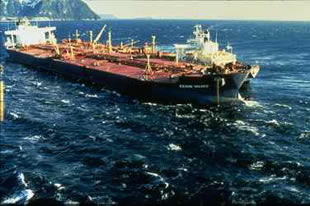
 |
Exxon Valdez oil remains. Why?March 23, 2007Courtesy of Far North Science 
The persistence of 85 tons of oil from the spill has surprised many scientists and confounded expectations that most of the crude would have long since disappeared and left the Sound's marine species completely recovered. Scientists at Auke Bay Laboratory in Juneau have tracked the fate of the crude oil for a decade. A study released in February, led by chemist Jeff Short, found alarming amounts of oil at 10 beaches studied in 2001 and 2005. This remaining oil - about 26,600 gallons from the original 11 million - appears to be declining at only about 4 percent per year. It has seeped four to 10 inches beneath the surface, where it continues to leach into ocean and get ingested by sea life. "Such persistence can pose a contact hazard to inter-tidally foraging sea otters, sea ducks, and shorebirds, create a chronic source of low-level contamination, discourage subsistence in a region where use is heavy and degrade the wilderness character of protected lands," wrote Short and eight co-authors in the study, published Feb. 15. Now, to help sort out why the oil still lingers, the Exxon Valdez Oil Spill Trustee Council has awarded a three-year $1.2 million grant to researchers at Temple University. "Every indication tells us that the oil should have biodegraded," says principle investigator Michel Boufadel, chair of Civil and Environmental Engineering in Temple's College of Engineering, in a release. "But what we've seen is there are still plenty of places where the oil still exists." A release from Temple University science writer Preston Moretz explains what's up: During the next two summers, Boufadel and graduate students will travel to Prince William Sound for 20 days and 50 days, respectively, to conduct field studies, take samples and try to get an understanding of the motion of the water and effects of the waves along the beaches. "Our goal is to understand what is happening at the oil-water interface, since that is where the biodegradation of oil typically occurs," said Boufadel, an expert in oil spill remediation. "We will be examining the biodegradation from both sides of that interface - from inside and outside the oil patches."
Boufadel said the researchers currently believe that micro-organisms, which would typically consume the oil, may play a key role in the oil's lack of biodegradation along the beaches. "You would expect that over 17 to 18 years, the micro-organisms that live in water along the beach would eat the oil; that they would consume it completely," Boufadel said. "That did happen at many locations, but at these particular locations that we will be examining, there have been some limitations on that occurring." Boufadel hypothesizes that the micro-organisms, which live in the water and need other nutrients to be able to consume the oil, may not be getting enough nitrogen, phosphorus or oxygen in order to do that. Or, he adds, a layer or sort of "skin" may have developed around the oil patches, making them impenetrable by the micro-organisms. Boufadel also believes that environmental factors such as temperature could be inhibiting the micro-orgamisms. "There may be enough nutrients, but the temperature may be so low that these micro-organisms cannot grow fast enough to consume the oil that lingers on these particular beaches," he said. Most of Far North Science is written and edited by Doug O'Harra, a writer and journalist based in Anchorage, Alaska. |
|